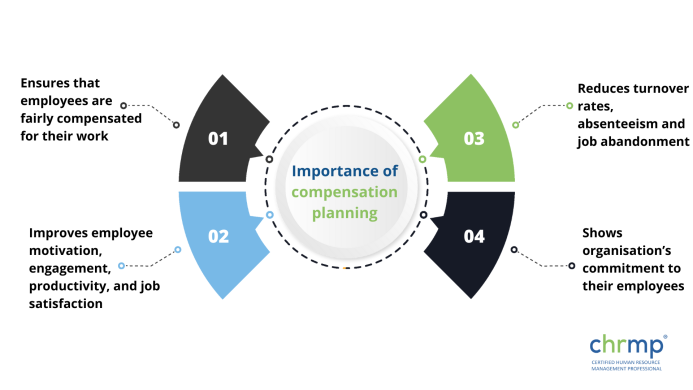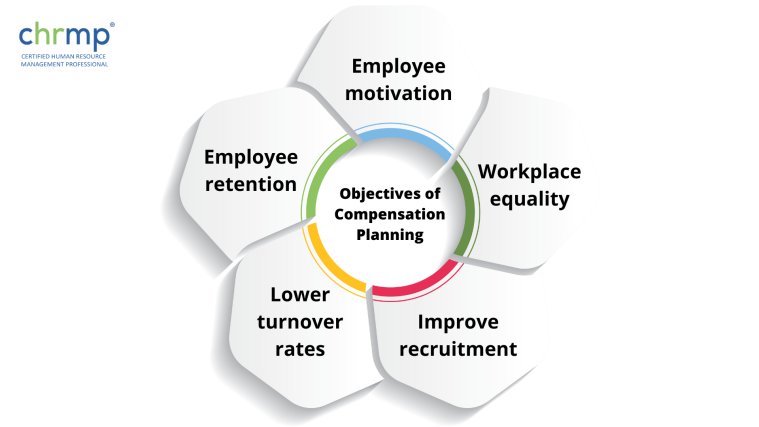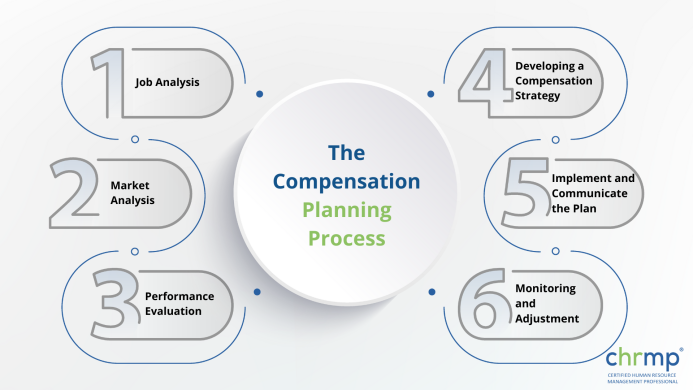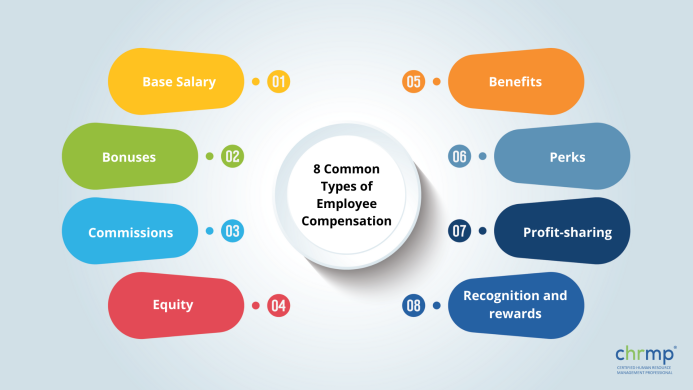

Attraction and retention of top talent can be achieved through careful compensation planning, which is crucial in motivating and inspiring the workforce to perform at their best level.
An effective compensation plan can help an organization become a competitive market benchmark, reduce turnover rates, and improve employee satisfaction and productivity.
An effective compensation plan can help an organization become a competitive market benchmark, reduce turnover rates, and improve employee satisfaction and productivity.
Critical components of compensation planning are discussed here in this blog, including job analysis, market research, performance evaluations, and the development and implementation of a compensation strategy.
We shall also discuss the importance of regular evaluation and adjustment of the compensation plan to ensure that it remains relevant and effective in meeting the needs of the organization and its employees.
Let’s get started without much further ado.
The process of developing and implementing a comprehensive strategy for compensating employees in an organization is called Compensation Planning.
Based on various factors such as job responsibilities, market trends, and organizational goals, an appropriate and particular kind of compensation package for each position will be determined for different industries.
The goal of compensation planning is to ensure that employees are fairly compensated for their work to derive work satisfaction and that the organization remains competitive in the market. Under paid workforce will be deprived of work satisfaction.
A well-designed compensation plan can help attract and retain top talent, improve employee morale, engagement and productivity, and reduce turnover rates.
Compensation planning is crucial for any organization as it ensures that employees are fairly compensated for their work, which in turn improves their motivation, engagement, productivity, and job satisfaction while at the same time reducing turnover rates, absenteeism and job abandonment.

By creating a comprehensive strategy for compensation, organizations can attract and retain top talent, reduce turnover rates, and become a competitive benchmark in the market. It is also an opportunity for organizations to show their commitment to their employees and their well-being, which can positively impact overall organizational culture.
A compensation-wise satisfied workforce displays traits like brand loyalty, improved morale, engagement and retention, i.e., a sense of belongingness to the workplace.
Regular evaluation and adjustment of the compensation plan are essential to ensure that it remains relevant and effective in meeting the needs of both the organization and its employees.
The objectives of a compensation plan are multifaceted, but they all serve the ultimate goal of aligning employee compensation with organizational objectives.
One objective is employee retention, which involves attracting and retaining qualified employees through a competitive and fair compensation package.
Another objective is employee motivation, which involves using compensation to motivate desired employee behaviour, such as meeting performance targets or achieving specific goals.

Workplace equality is also an important objective, which ensures fair pay and a similar pay package according to years of service, skills and qualifications are given to workgroups to avoid discrimination or resentment.
Providing a competitive pay structure to improve recruitment and retention and lower turnover rates and incidences of job abandonment is also a critical objective.
Finally, it is essential to follow legal requirements to ensure the compensation plan meets all legal obligations and complies with all government and company rules and regulations.
Organizations should ensure that their pay packages and compensation plan is effective in attracting, motivating, and retaining employees, which in turn can be achieved by meeting the objectives mentioned earlier.
Several factors can influence compensation planning, including:
The compensation packages offered by an organization should be in line with industry and market trends or a benchmark in the concerned sector to remain competitive and attract top talent. If an organization falls behind in terms of compensation, it risks losing skilled employees to competitors.
The compensation plan should align with the organization’s objectives, such as increasing sales and profits, reducing costs, and improving employee retention. The compensation plan should be like an incentive for employees to work towards achieving these objectives.
The compensation plan should be based on job analysis, which involves evaluating the job responsibilities, skills, and qualifications required for each position.
This analysis ensures that the compensation package to individual employees reflects the value of each role and how much each benefits the company’s bottom line in the long and short run.
The compensation plan should be based on employee performance and productivity, with high performers being rewarded more than low performers. This approach helps to motivate employees to perform at their best and fosters a culture of meritocracy rather than mediocrity.
Budget constraints can also influence compensation planning, as an organization may need help to afford high salaries or costly benefits packages due to the company’s current financial position. Therefore, the compensation plan must balance the need to attract and retain talent with the organization’s financial resources.
Legal requirements, such as minimum wage laws and anti-discriminatory regulations governing overtime pay, must be complied with when designing a compensation plan.
Non-compliance with legal requirements can result in legal action against the organization, and the negativity associated with law encroachment is a definite put-off for attracting and retaining top talent in the industry. Consulting with legal professionals and conducting regular audits can help to ensure compliance.
In conclusion, several factors can influence compensation planning, including industry, market trends, organizational objectives, job analysis, employee performance, budget constraints, and legal requirements. By considering these factors, organizations can design a competitive compensation plan that is aligned with organizational objectives and compliant with legal requirements at the same time sufficient to provide employees work satisfaction, engagement and motivation.
The compensation planning process involves several steps, including:

This step involves analyzing each job to determine its duties, responsibilities, and requirements. This information is used to create job descriptions and to choose the appropriate compensation for each role.
Compensation package to individual employees reflects the value of each role and how much each benefits the company’s bottom line in the long and short run.
Thorough research of the compensation trends in the industry and local job market to determine the appropriate pay range for each job.
This information is used to ensure that the organization’s compensation package is competitive enough or even a benchmark in the industry and is attractive to top talent and appropriately skilled people in the industry.
This step involves evaluating employee performance to identify top performers and areas for improvement. This information is used to determine performance or productivity-based pay increases or bonuses at the same time in balance with the current financial position of the company.
This step involves developing a comprehensive compensation strategy that outlines the types of compensation, such as base pay, bonuses, stock options, profit sharing, and benefits such as healthcare, retirement plans, and vacation time which are offered to employees in each position for their services rendered in the organization.
This strategy should be aligned with the organization’s goals, values and financial position.
This step involves implementing the compensation plan and communicating it to employees.
The plan should be communicated clearly. The employees should be made aware of the compensation package and other benefits they will receive for their employment in the organization and also how; on what basis their compensation is determined.
Regularly monitoring the compensation plan to ensure that it remains effective in achieving the organization’s objectives is important.
Compensation should be reviewed regularly, typically on an annual or bi-annual basis, to ensure that it remains competitive and aligned with organizational objectives. Adjustments may be necessary based on changes in the industry, the organization’s goals, or employee performance and productivity.
In summary, the compensation planning process involves job analysis, market analysis, performance evaluation, developing a compensation strategy, implementing and communicating the plan, and monitoring and adjusting the plan. By following these steps, organizations can ensure that their compensation plan is fair, competitive, and aligned with their goals and values.
There are different types of compensation that companies can offer to their employees. Some of the most common types of compensation include:

1.Base Salary:
This is the fixed amount of money an employee receives regularly (e.g., weekly, biweekly, monthly). It is usually based on factors such as job responsibilities, experience, and education.
2.Bonuses:
This is an additional payment that an employee receives based on their performance or the company’s performance. Bonuses can be tied to specific goals, such as hitting sales targets or completing a project on time.
3. Commissions:
This type of incentive pay is usually offered to salespeople or other employees who generate revenue for the company. Commissions are typically a percentage of the sales that the employee makes.
4.Equity:
This is an ownership stake in the company that is given to employees. Equity can come in stock options, restricted stock units, or other types of equity-based compensation.
5. Benefits:
These are non-cash benefits that companies offer to their employees, such as health insurance, retirement plans, and paid time off.
6. Perks:
These non-cash benefits are designed to make the workplace more enjoyable or convenient for employees. Examples include free snacks, gym memberships, and flexible work arrangements.
7. Profit-sharing:
This is a type of compensation that gives employees a share of the profits that the company earns. Profit-sharing can be distributed on a regular basis or at the end of the fiscal year.
8. Recognition and rewards:
This is a non-financial form of compensation that acknowledges an employee’s contributions to the company. Examples include employee of the month awards, public recognition, and professional development opportunities.
1. What is the purpose of compensation planning?
Compensation planning serves the purpose of ensuring that employees are fairly compensated for their work while also aligning their compensation with organizational objectives. It also helps to attract, retain, and motivate employees while remaining competitive in the job market.
2. How is compensation determined?
Compensation is determined by various factors, such as job responsibilities, employee performance, market trends, and budget constraints. Job analysis is performed to determine the value of each role, while market analysis helps to establish the appropriate compensation range.
3. What types of compensation are typically offered?
Types of compensation typically offered include base pay, bonuses, stock options, profit sharing, and benefits such as healthcare, retirement plans, and vacation time.
4. How often should compensation be reviewed?
Compensation should be reviewed regularly, and annually to ensure it remains competitive and aligned with organizational objectives. Performance evaluations may also be used to determine merit-based pay increases or bonuses.
5. How can an organization ensure that its compensation plan is legal and compliant?
Organizations can ensure their compensation plan is legal and compliant by staying up-to-date with applicable laws and regulations, such as minimum wage and anti-discrimination laws. Consulting with legal professionals and conducting regular audits can also help to ensure compliance.
In conclusion, compensation planning is critical for organizations looking to attract and retain top talent while ensuring fair pay and alignment with organizational objectives, which is vital to drive organizational success.
The key elements of compensation planning include job analysis, market analysis, performance evaluation, compensation strategy development, implementation, and monitoring and adjustment.
Compensation planning is a very complex process but crucial for any organization looking to build a solid and effective workforce, which is the biggest asset of any organization.
© 2007-2025 CHRMP| All Rights Reserved | Powered by Ripples Learning & Research Private Limited

Fill in the below details to get a C&B Program Plan.
